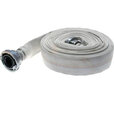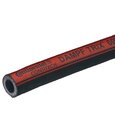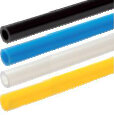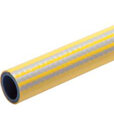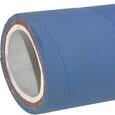Applications and Advantages of Flat Hoses in Industrial Settings
Figure 1: A lay flat hose for outdoor lawn or garden watering
Lay flat hoses can be easily rolled up and stored, making them ideal for tight spaces. For industrial applications, this allows them to be a versatile and efficient solution, particularly for water discharge and delivery requirements. This article discusses the advantages and main applications of lay flat hoses.
Table of contents
View our online selection of hoses!
What is a lay flat hose?
A lay flat hose doesn't have a helical wire and is designed to be laid flat when not in use, making it easy to transport and store. It is commonly made of PVC or rubber. A lay flat hose is simple to roll up and move and is only used for discharge or positive pressure applications. These hoses are used in agriculture, construction, industry, and mining.
Advantages
- Easy to store and move: Unlike regular hoses that can be bulky and difficult to handle, flat hoses are easy to store and move around. They are lightweight and can be folded, allowing for compact storage. This feature is convenient in automotive uses where there might not be a lot of room.
- Flexibility and versatility: Flat hoses are highly adaptable, making them simple to move around obstacles and sharp turns. Their unique design enables effortless rolling and unrolling, making them suitable for various tasks. They can be utilized for watering plants, extinguishing fires, or fluid management in vehicles.
- Durability and long life: For industrial purposes, durability is crucial. Flat hoses are constructed from top-grade elements such as reinforced PVC or rubber. This guarantees their resistance to wear and tear, holes, and exposure to UV light.
- Effective fluid transfer: Flat hoses have superior flow characteristics, enabling efficient fluid movement. Their smooth interiors reduce friction and pressure drop, guaranteeing an uninterrupted flow of liquids or gasses. This is especially significant in automotive uses, where steady and exact fluid movement is key for optimal performance. Flat hoses can enhance fuel economy, smoother functioning, and reduce idle time.
- Fast set-up and removal: Flat hoses are ideal for fast installation and removal because of their lightweight and adaptable design. In contrast to conventional hoses, which can require considerable time and effort to install or store, flat hoses can be swiftly put into use, conserving precious time during crucial tasks.
- High water flow capacity: Flat hoses are engineered to handle significant water flow effectively. They have a wide diameter and a smooth inside, which lessens any obstructions to flow, guaranteeing an excellent water delivery speed. This makes them perfect for moving large volumes of water rapidly.
- Resistance to tangles and kinking: Conventional hoses frequently encounter problems like twisting and kinking, which can disrupt the water flow. On the other hand, flat hoses guarantee a constant and unbroken water supply. This is particularly beneficial for transporting water over long distances or moving around obstructions.
Figure 2: A kinked garden hose
Applications
Lay flat hoses are used in various industries and sectors because of their versatility and efficiency. Here are some common uses:
Irrigation and agriculture
In farming, lay flat water hoses distribute water effectively to plants and fields. Their flexibility makes it simple to set up and move around, aiding farmers in maximizing water use and reducing waste. These hoses are also long-lasting and resistant to weather and UV rays, guaranteeing longevity.
Firefighting
In emergencies and firefighting, every second counts. Flexible hoses provide a rapid and effective method of supplying large volumes of water to extinguish fires. Their lightness and mobility enable firefighters to roll them out swiftly, assisting them to get to the fire more quickly. Moreover, these flexible hoses can carry much water, guaranteeing a powerful and efficient water flow to help combat fires.
Mining
In mining activities, there's often a need to manage water accumulation in underground or open-air mines. Flexible hoses play a crucial role in draining excess water from these locations. Their robust build and resilience to chemicals render them appropriate for the challenging conditions present in mining sites.
Construction
Construction areas frequently require the elimination of surplus water or sewage. Flexible hoses are useful in such scenarios as they manage the high flow rates required for water removal activities. Their longevity and ability to resist wear and tear make them perfect for use in demanding construction settings where the hoses may encounter coarse surfaces.
Choosing the right lay flat hose
To ensure the best performance and lifespan, it's important to choose the right lay flat hose for the specific use. Here are some factors to consider when choosing a lay flat hose:
- Hose diameter and length: A hose with a wider diameter can manage a greater flow of water. The length of the hose defines the distance water can be moved without a noticeable pressure drop.
- Pressure: It's critical to select a hose that can manage the pressure requirements without the danger of rupturing or leaking. Examine the operational and burst pressure (the highest pressure in the system) ratings of the flexible hose to confirm they can handle the water pressure and any possible surges in the application.
- Material and construction: Lay flat hoses are made from different materials, like PVC, rubber, or polyurethane. Always ensure the hose material is compatible with the fluids being transported and the environmental conditions it will be exposed to. Also, check the reinforcement layers in the hose construction to ensure it is durable and resistant to abrasion.
- Couplings and fittings: Select the correct fittings and connectors for secure and watertight connections. Ensure the hose and associated fittings have compatible end connections, and choose top-quality couplings that can endure the application's demands.
Maintenance
To get the most out of the lay flat hose's lifespan and performance, use these maintenance tips:
- Regular inspection: Regularly check the lay flat hose for any signs of damage like cuts, abrasions, or bulges. If damaged, replace the hose immediately to avoid leaks or bursts during use.
- Proper storage: When the lay flat hose is not in use, store it in a clean, dry area away from direct sunlight or extreme temperatures. Avoid any sharp objects or heavy items that could damage the hose.
- Cleaning and drying: After each use, clean the lay flat hose with clean water to remove any leftover residue or contaminants. Ensure the hose is completely dry before storing it to prevent the growth of mold or mildew.
- Avoid chemical exposure: Some chemicals can break down the materials of the lay flat hose. Keep the hose away from chemicals or fluids incompatible with the hose material. Check the manufacturer's guidelines for chemical compatibility and take necessary precautions to avoid chemical exposure.
- Proper handling and transport: Carefully handle the lay flat hose to avoid excessive bending, dragging, or pulling, which can cause damage or kinking. When moving the hose, roll or fold it properly to prevent tangles and make deployment easier when needed.
- Periodic testing: Regularly test the lay flat hose to ensure its quality and performance. This might involve doing pressure tests or flow tests to find any potential problems and make necessary adjustments or replacements.
Read our industrial coolant hoses article for more details on the hoses used to transport coolants.
FAQs
What is a lay flat hose?
A lay flat hose is a flexible, lightweight hose that can lay flat and is used for the discharge or delivery of water in various industries.
What materials are in lay flat hoses?
Lay flat hoses are typically made from materials like PVC (polyvinyl chloride), polyurethane, or rubber, depending on their intended use and durability requirements.
What are lay flat hose fittings?
Layflat hose fittings are connectors used to attach layflat hose to other equipment, such as pumps, tanks, and sprinklers.




